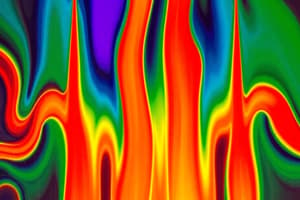Podcast
Questions and Answers
What is the primary mechanism of heat transfer between two substances in physical contact?
What is the primary mechanism of heat transfer between two substances in physical contact?
Conduction
What is the unit of measurement for temperature that is used as a standard unit in scientific research?
What is the unit of measurement for temperature that is used as a standard unit in scientific research?
Kelvin (K)
What is the term for the energy required to change the temperature of a substance by 1°C?
What is the term for the energy required to change the temperature of a substance by 1°C?
Heat capacity
What is the term for the energy required to change a substance from a solid to a liquid at constant temperature?
What is the term for the energy required to change a substance from a solid to a liquid at constant temperature?
What is the unit of measurement for heat that is commonly used in nutrition and chemistry?
What is the unit of measurement for heat that is commonly used in nutrition and chemistry?
What is the term for the transfer of heat through electromagnetic waves?
What is the term for the transfer of heat through electromagnetic waves?
Flashcards are hidden until you start studying
Study Notes
Definition of Heat
- Heat is a form of energy that is transferred from one body to another due to a temperature difference.
- It is a form of kinetic energy associated with the motion of particles in a substance.
Transfer of Heat
- Heat can be transferred through three main methods:
- Conduction: Direct transfer of heat between particles in physical contact.
- Convection: Transfer of heat through the movement of fluids.
- Radiation: Transfer of heat through electromagnetic waves.
Measurement of Heat
- Heat is typically measured in units of energy, such as:
- Joules (J)
- Calories (cal)
- Kilocalories (kcal)
- Temperature is a measure of the average kinetic energy of particles in a substance, measured in units of:
- Celsius (°C)
- Fahrenheit (°F)
- Kelvin (K)
Heat Capacity
- Heat capacity is the amount of heat energy required to change the temperature of a substance by 1°C.
- Specific heat capacity is the heat capacity of a substance per unit mass, measured in J/g°C.
Latent Heat
- Latent heat is the energy required to change the state of a substance (e.g. from solid to liquid or liquid to gas) at constant temperature.
- Latent heat of fusion is the energy required to change a substance from solid to liquid.
- Latent heat of vaporization is the energy required to change a substance from liquid to gas.
Definition and Nature of Heat
- Heat is a form of energy that is transferred due to a temperature difference between two bodies.
- It is a form of kinetic energy associated with the motion of particles in a substance.
Methods of Heat Transfer
- Conduction: direct transfer of heat between particles in physical contact.
- Convection: transfer of heat through the movement of fluids.
- Radiation: transfer of heat through electromagnetic waves.
Units of Measurement for Heat and Temperature
- Heat is measured in units of energy, including:
- Joules (J)
- Calories (cal)
- Kilocalories (kcal)
- Temperature is measured in units of:
- Celsius (°C)
- Fahrenheit (°F)
- Kelvin (K)
Heat Capacity
- Heat capacity: the amount of heat energy required to change the temperature of a substance by 1°C.
- Specific heat capacity: the heat capacity of a substance per unit mass, measured in J/g°C.
Latent Heat
- Latent heat: the energy required to change the state of a substance at constant temperature.
- Latent heat of fusion: the energy required to change a substance from solid to liquid.
- Latent heat of vaporization: the energy required to change a substance from liquid to gas.
Studying That Suits You
Use AI to generate personalized quizzes and flashcards to suit your learning preferences.




